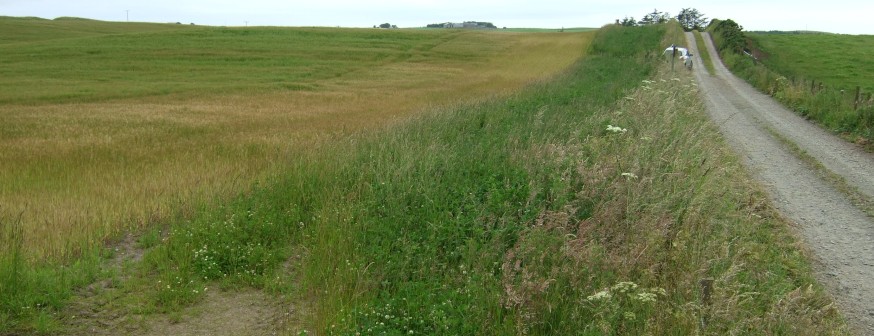Supporting guidance for Grass Strips in Arable Fields
Date published: 30 March, 2015
The Grass Strips in Arable Fieldsoption supports the management of grass strips in or at the edges of arable fields.
Soil, water quality and wildlife benefits
Grass strips around the edge, or within arable fields, can have many benefits:
- 'beneficial' insects like predators (such as spiders) and pollinators (such as bees) will thrive using them year-round to feed and hibernate
- they will be used by birds like grey partridge, and mammals such as hares and voles
- they can contribute to habitat networks and add habitat diversity alongside hedges and woodland
- across the slope of an arable field they can reduce diffuse water pollution by intercepting soil and water run-off and so reduce loss of soil and nutrients
- by slowing surface-water flow rates they can also help reduce flooding downstream
- managing 10 to 20 metre grass strips (cut after 15 August) around cereal fields in corn bunting areas could provide attractive nesting habitat if tall / dense enough

Which fields to choose?
All grass strips are beneficial for wildlife. Extra benefit can be gained from strips established alongside hedges, or other field boundaries such as dykes, grassy banks or woodlands or as corridors to connect patches of habitat such as woodland and wetland.
Grass strips in arable fields can be used to break up large field areas to allow beneficial insects further access into cropping areas, or can be located running across a sloping field to intercept soil and water run-off in fields susceptible to soil erosion.
How wide should my grass strip be?
In general, the wider the grass strip, the better for soil and water quality and wildlife.
For grass strips along the contour of the field consider the steepness of the field. In general, the longer the slope, the steeper the slope and the less free draining the adjacent field is the wider the grass strip you will need to slow the surface-water flow.
You may also want to take into account how you will manage the grass strip. You may want to choose a width which will allow you easy access for machinery to cut the vegetation, or will help you graze it.
You can manage any width of strip from a minimum of three metres to a maximum of 20 metres. For strips next to a hedge, the strip has to start at the centre line of the hedge and the first two metres are ineligible for payment as only activity which exceeds legal requirements is eligible for payment.
Under GAEC 7 you cannot cultivate or apply fertiliser or pesticides within two metres of the centre line of a hedge. Therefore, if you apply for a three metre grass strip next to a hedge then your payment would be for a one metre strip (three metres minus two metres ineligible width) multiplied by the length of the grass strip.
Looking after your grass strip
Cut or graze the grass strip after 15 August. This will allow flowers to set seed and also remove annual growth to prevent a build-up of matted material and a build-up of nutrients in the grass strip.
Wildlife habitats benefit from low levels of nutrients and cutting or grazing will maintain a greater range of plants and animals in the grass strip. For best effect, the margin should be cut or grazed to approximately 10 centimetres.
You can get prior approval to not cut or graze a grass strip if you can demonstrate it benefits biodiversity and will not reduce water quality.
Grass strips across sloping fields need vegetation long enough to slow the flow of water and trap sediment. Ideally it will be at least 10 to 15 centimetres tall.
Where grazing then grazing avoid poaching, and maintain the grass at about 10 to 15 centimetres.
You can use grass strips across arable fields as one of severalmeasures to protect soil and water quality. Grass strips can intercept soil andwater run-off. You can complement them with other measures including:
- ploughing across the slope to reduce run-off
- nutrient management planning to reduce the risk of applying excess fertiliser or manure (so that excess nutrients do not run off the field)
- keep your arable field free from compaction and maintain levels of organic matter to help water to soak into cropped soils and reduce the amount of sediment likely to run off
- create and manage water margins to provide extra protection and wildlife benefits where your arable field is adjacent to water
Managing 10 to 20 metre grass strips (cut after 15 August) around cereal fields in corn bunting areas could provide attractive nesting habitat if tall / dense enough.
How to increase the success of the option
- use the information in your environmental audit to identify the best locations to benefit biodiversity and to identify the highest risks and most relevant measures to address diffuse pollution or to slow flows for flood risk management
- for diffuse pollution, the steepest slopes and the most erodible crops will benefit most from grass strips across the slope of a field. Steeper slopes will need wider grass strips
- use other measures in conjunction with the grass strip to slow water flows and trap sediment
- for biodiversity, use grass strips to create physical links between existing habitats such as woodland, grassland, wetlands and hedgerows or create extra habitat diversity alongside hedges or woodlands
